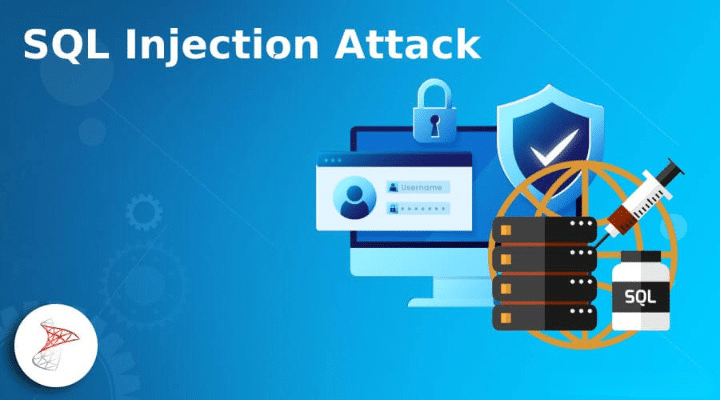SQL Injection Attack
In this tutorial, we are going to discuss about SQL Injection Attack. A SQL injection attack is a type of cybersecurity vulnerability that occurs when an attacker inserts malicious SQL code into input fields of a web application, with the intention of manipulating the database backend. This exploit takes advantage of poor input validation or improper handling of user-supplied data by the application.
Here’s how a SQL injection attack typically works:
- Injection Point: The attacker identifies a vulnerable input field in a web form, URL parameter, or any other user-controllable input field that interacts with the application’s database.
- Malicious Payload: The attacker injects malicious SQL code into the vulnerable input field. This code can include SQL commands, query fragments, or even entire SQL statements.
- Execution: When the application processes the user input, it constructs a SQL query by concatenating the user-supplied data with the SQL code. If the application does not properly sanitize or validate the input, the injected SQL code is executed by the database server.
- Database Manipulation: The injected SQL code can perform various malicious actions, including:
- Retrieving sensitive data from the database (e.g., usernames, passwords, credit card numbers).
- Modifying or deleting database records.
- Executing administrative commands on the database server.
- Data Exfiltration or Damage: The attacker can extract sensitive information from the database or cause data loss, data corruption, or service disruption.

SQL injection attacks can have serious consequences, including unauthorized access to sensitive data, data breaches, financial losses, reputational damage, and regulatory penalties.
In the case of Simple Statement every time the query will send to the database with user provided input values. Every time the query will be compiled and executed. Some times end user may provide special characters as the part user input,which may change behaviour of sql query.This is nothing but SQL Injection Attack,which causes security problems.
But in the case of PreparedStatement query will be compiled at the beginning only without considering end user’s input. User provided data will be considered at the time of execution only. Hence as the part of user input,if he provides any special characters as the part of input, query behavior wont be changed. Hence there is no chance of SQL Injection Attack in PreparedStatement.
E.g
select count(*) from users where uname='"+uname+"' and password='"+password+"'";If the end user provides username as ashok.mariyala and password as Kumar@12345 then the query will become
select count(*) from users where uname='ashok.mariyala' and password='Kumar@12345';The query is meaningful and it is validating both username and password. If the end user provides username as ashok.mariyala’– and password as Kumar@12345 then the query will become
select count(*) from users where uname='ashok'--' and password='Kumar@12345';It is not meaningful query because it is validating only username but not password. i.e., with end user’s provided input the query behavior is changing, which is nothing but SQL injection attack.
Note
— Single Line SQL Comment
/* Multi Line SQL Comment */
select * from users where user_id = enduserprovidedinput;
select * from users where user_id = 101;
returns record information where user_id = 101;
select * from users where user_id = 101 OR 1=1;Here 1=1 is always true and hence it returns complete table information like username, password, user_id etc. which may create security problems.
SQL Injection Attack with Statement
SQL Script
create table users(uname varchar2(20),upwd varchar2(20));
insert into users values('ashok.mariyala','Kumar@12345');
insert into users values('vinod.mariyala','Vinod@321');SQLInjectionDemo
import java.sql.*;
/**
*
* @author ashok.mariyala
*
*/
public class SQLInjectionDemo {
public static void main(String[] args) throws Exception {
String sqlQuery = "select count(*) from users where uname = '"+uname+"' and password = '"+password+"'";
Class.forName("oracle.jdbc.OracleDriver");
Connection con = DriverManager.getConnection("jdbc:oracle:thin:@localhost:1521:XE","scott","tiger");
Statement st = con.createStatement();
Scanner sc = new Scanner(System.in);
System.out.println("Enter Username : ");
String uname = sc.next();
System.out.println("Enter Password : ");
String password = sc.next();
ResultSet rs =st.executeQuery(sqlQuery);
int c=0;
if(rs.next()) {
c = rs.getInt(1);
}
if(c==0)
System.out.println("Invalid Credentials");
else
System.out.println("Valid Credentials");
con.close();
}
}Output
java SQLInjectionDemo
Enter Username : ashok.mariyala
Enter Password : Kumar@12345
Valid Credentials
java SQLInjectionDemo
Enter Username : ashok.mariyala'--
Enter Password : Ashok@12345
Valid CredentialsSQLInjectionDemo using PreparedStatement
import java.sql.*;
/**
*
* @author ashok.mariyala
*
*/
public class SQLInjectionDemo {
public static void main(String[] args) throws Exception {
String sqlQuery = "select count(*) from users where uname = ? and password =?";
Class.forName("oracle.jdbc.OracleDriver");
Connection con = DriverManager.getConnection("jdbc:oracle:thin:@localhost:1521:XE","scott","tiger");
PreparedStatement pst = con.prepareStatement(sqlQuery);
Scanner sc = new Scanner(System.in);
System.out.println("Enter Username : ");
String uname = sc.next();
System.out.println("Enter Password : ");
String password = sc.next();
pst.setString(1,uname);
pst.setString(2,password);
ResultSet rs =st.executeQuery(sqlQuery);
int c=0;
if(rs.next()) {
c = rs.getInt(1);
}
if(c==0)
System.out.println("Invalid Credentials");
else
System.out.println("Valid Credentials");
con.close();
}
}Output
java SQLInjectionDemo
Enter Username : ashok.mariyala
Enter Password : Kumar@12345
Valid Credentials
java SQLInjectionDemo
Enter Username : ashok.mariyala'--
Enter Password : Ashok@12345
InValid CredentialsThat’s all about the SQL Injection Attack. If you have any queries or feedback, please write us email at contact@waytoeasylearn.com. Enjoy learning, Enjoy Java.!!